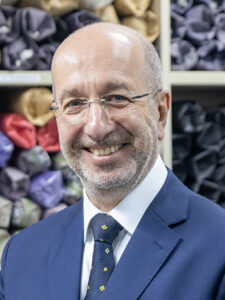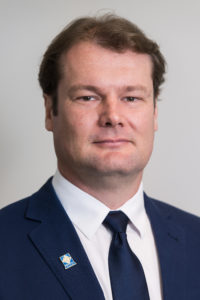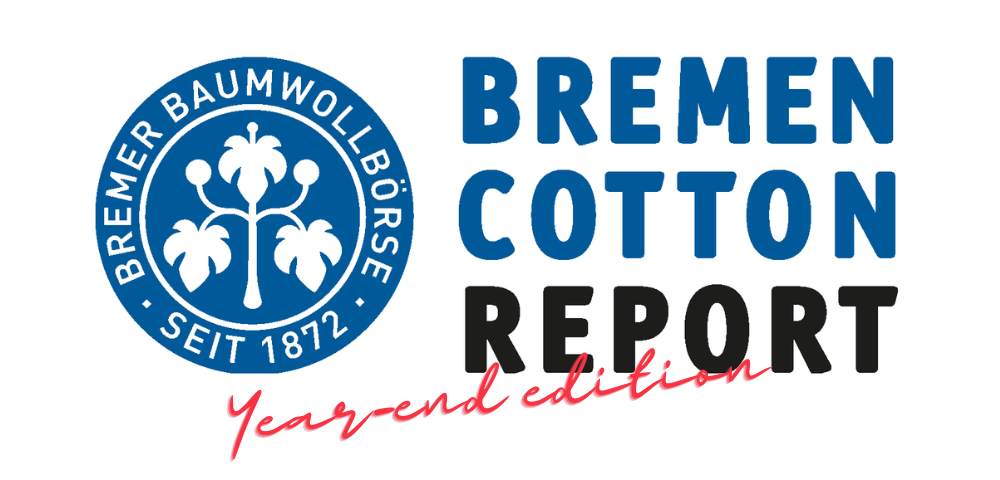In our traditional year-end edition of the Bremen Cotton Report, experts from various areas of the cotton industry and the textile value chain have their say. In short statements, they analyze current challenges in the industry and throw a glance at the coming year.
Jean-Paul Haessig,President Bremen Cotton Exchange and Director Asian Cotton Traders, Ho Chi Minh City, Vietnam
Where do you currently see the greatest challenges in the cotton industry?

For players in the cotton supply chain, the current market and price trends are an absolute priority. There are a number of challenges at present due to slower demand. Long term, however, we are seeing massive regulatory efforts, in particular at European level, which will have consequences for the textile industry as a whole. Supply chain legislation, environmental footprint, circular economy, the waste directive, eco-design – a large number of current legislative proposals at European level are having a direct or indirect impact on textile production and thus on the cotton supply chain.
Another ongoing challenge is the positioning of cotton in the fibre market. For us as the Bremen Cotton Exchange, it is important that brands and retailers know how sustainable cotton is as a fibre – and that this is fact-based. This requires education based on scientific findings about the decisive characteristics of the natural fibre cotton: it is biodegradable, renewable and cultivated in a climate-neutral way. All of these properties should make cotton the preferred fibre in many textile products.
Anna Rüchardt, Head of Impact and Responsibility, HAKRO, Schrozberg, Germany
As a new member of the steering committee – what, in your opinion, are the key tasks for the Partnership for Sustainable Textiles over the next two years?

The Partnership for Sustainable Textiles is in the unique position of being able to unite the sector’s various stakeholder groups in their efforts towards making effective changes in supply chains. We are working from different perspectives for the same improvements in so many areas. Bundling these efforts and consolidating our commitment shall remain a core focus for the Partnership in the future.
Open and constructive stakeholder dialogue that includes all supply chain voices can enable us to take targeted measures to minimise risks, thereby creating an impact in supply chains as well as on the sector that goes far beyond meeting growing legal requirements.
Alexandre Schenkel, President, Abrapa, Brasilia, Brazil
What are the success factors of Brazilian cotton production, are you planning any major changes in the coming seasons?

Brazil‘s success in cotton farming has been built up day by day since the turn of the 2000s, with the migration of cotton production to the center-west of Brazil. The convergence of factors such as climate and soil conditions, technology, professionalism and sustainable practices, combined with the strategic direction of the institution that brings together all cotton growers, Abrapa, has taken the country from being the second largest importer of cotton in the late 1990s to the second largest exporter in the last decade.
We see many opportunities for the future. To this end, we continue to invest heavily in sustainability and quality, as well as in traceability and the promotion of our fiber, establishing a clear dialogue with all the links in the production chain and giving the market the assurance that we are a reliable, responsible origin, constant in supply, and that we have one of the best cottons in the world.
Dr Christian Schindler, Director General, International Textile Manufacturers Federation, Zurich, Switzerland
From your point of view, what measures would help with the weakening situation in global textile production?

After 2021 and 2022, which were both very good years for the textile industry worldwide, 2023 became extremely difficult. It was characterised by increasing costs on the supply side and cautious consumption on the demand side. The textile industry found itself caught in a perfect storm, which lasted longer than initially expected.
As many retailers are sitting on high stock volumes – built up in 2022 in anticipation of continued high demand – these must firstly be reduced to a normal level. This has been slow so far but should have accelerated in November (Black Friday) and continued in December (Christmas). With decreasing stock levels comes the need for placing new orders in the textile industry.
Sharply declining inflation, the end of rising interest rates, global economic growth of around three percent and decreasing stocks should ensure that the demand for textiles is likely to increase again in 2024.
Anish Koundanya, Director Sales & Marketing Strategy and Consulting, Global Business Solutions, Arani, India
What trends will shape the Indian cotton market in 2024?

The provincial governments in northern India estimate that 65 pecent of cotton production have been severely damaged by Pink Boll Worm in 2023. This will be the key challenge for Indian cotton in 2024. Labour wages are linked to quantity picked. Lower yield means lower pay. In 2023, farmers could not get labour to pick cottons owing to lower yields/pay.
After 2014, yields are down 14-15 percent. Since 2019/20, yield and production have declined by seven percent and 12 percent respectively. Despite an import duty on cotton in 2022/23 cotton imports increased by 73 percent over 2021/22.
The Quality Control Order for Cotton of the Indian Bureau of Standards takes effect in August 2024. It aims to regulate and standardize the quality of ginned Indian cotton. The branding effort “Kasturi Cotton” aims to deliver a superior quality fibre together with traceability.
Kim Hanna, President, International Cotton Association, Liverpool, UK
As the first woman to head the ICA, what will you do differently?

It’s important to recognize the ICA‘s history and its unparalleled safe trading platform which has been the backbone of the industry. It’s joint venture, ICA Bremen, also continues to thrive promoting excellence in cotton quality testing.
As ICA President, embracing inclusivity and connectivity will be my main ambition for 2024. Soon, I‘ll chat with the spinners committee, eager to hear their ideas and encourage engagement. A retailer committee with global brands is underway to understand needs and help retailers navigate the supply chain in compliance with relevant policies.
Collaboration with like-minded organizations can highlight the ecological and social benefits needed to make cotton a leader in global sustainability. Preserving the ICA‘s legacy is important, but steering the cotton industry towards a sustainable future is equally crucial. Extending our reach ensures the ICA leads positive change in this evolving landscape.
Carolin Franitza, Stakeholder Manager, Oeko-Tex, Zurich, Switzerland
What changes can we expect on the certification market in 2024?

The focus for 2024: data accessibility and traceability. The growing demand for natural materials such as cotton promotes an increasing awareness of the social and environmental risks involved in raw material extraction and emphasises the importance of regenerative cultivation methods, biodiversity and a living wage.
Traceability from the fibre through to the end product enables us to identify the origins of cotton and ensure fair working conditions and environmental standards. This transparency enables companies to meet sustainability goals and build consumer trust.
Verification through certification plays a crucial role. However, it is a complex challenge that is currently often performed manually. The digitalisation of tracking systems is an important step. A joint commitment by certification bodies to the harmonisation and exchange of data can serve as a catalyst in this respect.
Eric Trachtenberg, Executive Director, International Cotton Advisory Committee, Washington, D.C., USA
What are your plans for the ICAC as the new Executive Director, what changes will there be?

ICAC’s mission is to support and strengthen the global cotton economy by providing data, technical information, and analysis on cotton production, consumption, and trade. ICAC oversees instrument testing to make cotton trading more efficient and serves as a forum to address issues of international significance through collaboration with our Member governments, the private sector, civil society, and subject matter experts.
After extensive consultations with our stakeholders, ICAC is reimagining its work. To better support the global cotton economy, ICAC plans to redouble its efforts in agricultural development, sustainability, and traceability. We are also preparing to expand our activities in the textiles sector, deepen our connectivity with brands and retail, and make a positive case for cotton – by telling the truth about it.
ICAC looks forward to working with all those who share our goal of promoting a vibrant global cotton economy to support economic growth and the environment, while benefiting everyone on the value chain from farm to consumer.
Christian Lanvermann, Senior Marketing Manager, Fruit of the Loom, Kaiserslautern, Germany
Cotton clothing has always been a strong core of the Fruit of the Loom brand – will this continue to be the case in the future?

Absolutely. Cotton was, is and will continue to be the most important raw material for us. We produce around two million garments a week at our own production site in Morocco. All of our T-shirts are made of 100 percent cotton. As of next year, we will also be processing organic cotton. There is still a high demand in our industry for natural fibres such as cotton, and organic cotton in particular.
Nowadays though, it’s not just about the textile itself. Customers are not only asking for sustainable raw materials. It is also important to them under which circumstances garments are produced and that the price is and remains affordable. We can proudly say that we are very well positioned in this respect. We operate a modern, sustainable production with great employees. As our manufacturing base is so close to Europe, we can deliver our products quickly and leave a lower carbon footprint.
Graham Soley, Agricultural Economist, USDA Foreign Agricultural Service, Washington, D.C., USA
How will the world cotton market develop over the next three years?

Forecasting cotton demand has been anything but certain since the onset of COVID-19. Although spinning capacity has recently expanded in markets including China, Turkey, and South Asia, global operating rates have declined since last year. Apparel and home textile purchases must return to trendline growth in major consuming markets including the European Union and China to support greater cotton demand in the future.
Cotton prices also remain high relative to synthetic fibers. Over the past decade, China’s significant rise in synthetic fiber production and capacity continues to suppress any substantial climb in synthetic prices. If the relative price of cotton continues to rise, this will pressure future cotton demand further below its trendline growth.
Antonios Siarkos, President, European Cotton Alliance, Larissa, Greece
What are the next steps for the EUCOTTON initiative?

The EUCOTTON initiative is gaining momentum. Consumers are increasingly demanding to know the origin of the materials in the garments they buy, and the sustainability of their supply chain. At the beginning of new year, the European Cotton Alliance is launching the EUCOTTON management system and its traceability platform with the view of managing the use of the EUCOTTON label to the supply chain. This method will manage full traceability of the product flow throughout the supply chain and will ensure full transparency and detailed info for the labelling and the digital passport of textile products.
Currently, the European Cotton Alliance is implementing an ambitious and innovative promotion campaign aiming to increase the awareness and recognition of the European cotton, adding a very strong focus towards its quality and sustainability properties. “Europe designs a sustainable future with cotton from Europe” is the main slogan of the campaign.

